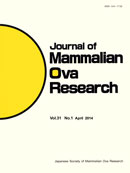巻号一覧

31 巻 (2014)
- 4 号 p. 95-
- 3 号 p. 61-
- 1 号 p. 1-
前身誌
31 巻, 3 号
選択された号の論文の5件中1~5を表示しています
- |<
- <
- 1
- >
- >|
Mini Symposium
-
Koji SUGIURA2014 年 31 巻 3 号 p. 61
発行日: 2014年
公開日: 2014/11/29
ジャーナル フリーPDF形式でダウンロード (288K) -
Yayoi Obata2014 年 31 巻 3 号 p. 62-69
発行日: 2014年
公開日: 2014/11/29
ジャーナル フリーEpigenetic modification is the main mechanism of transcriptional regulation that does not involve changes in DNA sequences, such as DNA methylation, acetylation and methylation of the N-terminal tail of histone. Recently, next-generation sequencing technology has provided detailed information about the DNA methylation status of the whole mouse genome in full-grown oocytes. However, it is still very hard to read histone codes in oocytes because a large number of cells (1 × 106 cells or more) are needed for such analyses. In addition, information that can be obtained from immunostaining analysis is limited to a global image of histone modification in oocytes. Consequently, a complete picture of individual epigenetic modifications in mouse oocytes has not yet been understood. In this paper, the DNA methylation required for functional oocytes is reviewed. The differences in DNA methylation between oocytes grown in vivo and in vitro, and the potential for manipulating epigenetic modifications in oocytes are also discussed.抄録全体を表示PDF形式でダウンロード (1603K) -
Katsuhiko Hayashi, Mitinori Saitou2014 年 31 巻 3 号 p. 70-78
発行日: 2014年
公開日: 2014/11/29
ジャーナル フリーOne of the paramount goals in reproductive biology is to produce functional oocytes in culture through a series of differentiation processes that accurately mimic those in vivo. Such a culture system would provide a larger number of oocytes than those available in vivo, which would be of help in the elucidation of mechanisms underlying germ cell development. All germ cells originate from a small group of primordial germ cells (PGCs) that segregate from somatic cell lineages at an early developmental stage. Recently, we developed a culture system in which embryonic stem cells (ESCs) and induced pluripotent stem cells (iPSCs) differentiate into PGC-like cells (PGCLCs) through an epiblast-like cell population. PGCLCs are capable of differentiating into functional oocytes when transplanted into the ovarian bursa with E12.5 gonadal somatic cells. In this review, we introduce our differentiation method and discuss possible applications of this culture system.抄録全体を表示PDF形式でダウンロード (1787K) -
Yuji Hirao, Takashi Miyano2014 年 31 巻 3 号 p. 79-85
発行日: 2014年
公開日: 2014/11/29
ジャーナル フリーMammalian ovaries contain a large number of oocytes, most of which degenerate either before or during the various stages of growth. To utilize these potential female gametes stored in the ovary, it is essential to develop a culture system that can provide a suitable alternative environment for oocytes to achieve full growth and competences to undergo meiotic maturation, fertilization, and embryonic development. In this review, the culture systems developed for bovine and porcine oocyte–granulosa cell complexes, at approximately the late mid-growth stage, are discussed. The culture systems are broadly divided in two types, the sphere system and substratum-adhering system. In the former system, a matrix such as collagen is utilized to maintain the 3-D structure of the follicles/oocyte–granulosa cell complexes. The latter system is characterized by the use of high concentrations of polyvinylpyrrolidone (molecular weight: 360,000), which positively affects the growth and competence of the oocytes. The quality and competence of the oocytes grown in these systems are discussed.抄録全体を表示PDF形式でダウンロード (1327K)
Original
-
Saiichi Furukawa, Yuta Matsuno, Chihiro Emori, Wataru Fujii, Kunihiko ...2014 年 31 巻 3 号 p. 86-92
発行日: 2014年
公開日: 2014/11/29
ジャーナル フリーSignals from fibroblast growth factors (FGFs) play a critical role in regulating the development of ovarian granulosa cells; however, the expression and regulation of FGF receptors are not well understood. The present study was conducted to assess the expression kinetics of transcripts encoding FGF receptors (FGFRs) during granulosa cell development in mice. In addition, the effects of oocytes on the levels of Fgfr transcripts were examined, as well as the expression of FGFR mRNA expression in porcine granulosa cells. All four types of Fgfr transcripts were detected in cumulus and mural granulosa cells with a tendency toward higher expression levels in mural granulosa cells. Interestingly, the expressions of Fgfr1 and Fgfr2 mRNA in cumulus cells were suppressed by co-culture with oocytes, whereas their expression in mural granulosa cells was promoted. Porcine cumulus cells expressed higher levels of FGFR1 and FGFR2 mRNA than mural granulosa cells. The results show that FGF receptor expression in granulosa cells, at least at the mRNA level, is dynamically regulated during follicular development, and that oocytes participate in the regulation of differential expression between cumulus and mural granulosa cells. Moreover, the regulation of transcripts encoding FGF receptors in granulosa cells may differ between mice and pigs.抄録全体を表示PDF形式でダウンロード (774K)
- |<
- <
- 1
- >
- >|